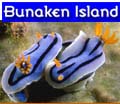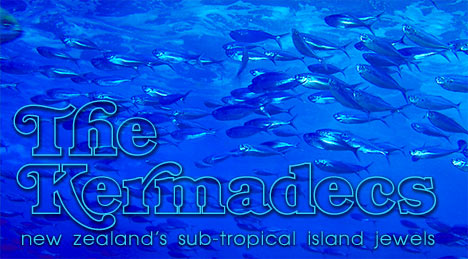
 |
Early the next morning
we were close to Raoul Island and soon after breakfast were sampling the
diving at Dougall Rock on the southern side of the island. Here the bottom
plummets to 300 metres or more within a stones throw from the rock and
the natural up-welling of current ensures a concentration of marine life.
For much of the dive, a group of ten sharks followed John and I around
the rock towards its northeastern corner where the wall drops down, down,
down to somewhere I badly wanted to go.
During this dive I saw my first striped boar fish hanging out in a cave
beneath a large rock. I had never seen one of these colourful and strikingly
patterned fish before but in subsequent dives around Raoul Island found
heaps of them hanging out in groups of up to ten.
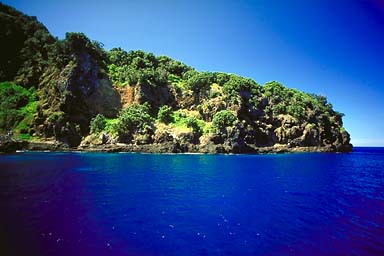 |
On this dive we also
came across several of the large spotted black grouper, undoubtedly one
of the big underwater attractions of the Kermadecs. These fish do occur
in relatively small numbers in north eastern New Zealand but they are
much more abundant and grow to a much larger size at the Kermadecs. Their
other striking characteristic is the ease with which they can be approached.
On a later dive we were to find ourselves in a spot where there seemed
to be dozens of these gentle giants. Here I followed a fish weighing perhaps
50 kg (110 lb) into a hole beneath a rock only to have him swim up to
me and rest his huge head on my camera only inches away from my face.
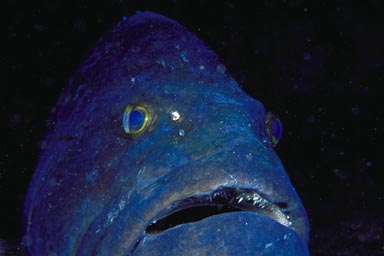 |
After our dive at
Dougall Rock we headed for the sheltered waters of the nearby Boat Cove
to anchor up for lunch. Since arriving at the southern islands we had
been communicating on the radio with the Department of Conservation (DOC)
staff stationed on Raoul. Their desperate need of company became obvious
when they invited us, even me, to a barbecue on the island that evening.
The Kermadecs simply don't get a lot of visitors and it is a fairly isolated
existence for the DOC staff stationed on Raoul. There happened to be another
boat sheltering at the islands when we arrived but the DOC guys later
told us that these were the first visitors they'd had for 85 days.
As we sat anchored in the clear waters of Boat Cove we could see several
sharks cruising around and with the sun blazing, it seemed like too good
a photographic opportunity to miss. Although feeling a little apprehensive
about jumping in with the sharks we'd spent so much diving with them it
seemed kind of silly to be concerned about going for another swim with
them. After setting up my camera and getting into my wet suit I jumped
in.
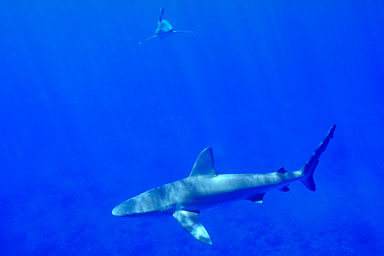 |
Around mainland New
Zealand sharks are seldom seen underwater by divers. Despite the fact
that there's plenty of them about, they probably sense the presence of
divers from a long way off and stay well clear of them. At the Kermadecs
the sharks seem to display no such tendencies of shyness. On my entry
into the water the sharks nearby showed no alarm and and immediately began
taking an obvious interest in me. With each swim past me they came a little
closer until I decided I was getting a little cold or feeling a little
hungry or had run out of film or some such excuse.
Present in numbers throughout almost every dive, these mainly galapagos
sharks (Carcharhinus galapagensis) mixed with a few grey reef sharks
(Carcharhinus amblyrhynchos) were for me the most striking underwater
attraction of the Kermadecs. Reading up about them back at home the book
"Sharks and Rays of New Zealand" describes the galapagos shark
as "aggressive and dangerous". I don't know about the dangerous
thing. For me, any risk is more than offset by the opportunity to swim
with such beautiful animals in an environment where their behavior is
probably very little modified by man.
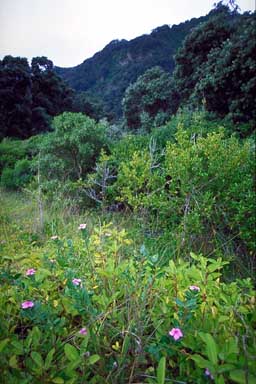 |
That afternoon we
had another good dive at Meyer Island after which the thought of standing
on something that didn't move took on great appeal. Our attempts to get
ashore were hampered by the swell rolling in at Fishing Rock, the landing
point. A group of us first approached the landing point in Atu's inflatable
dinghy but were left feeling very vulnerable when the motor cut out near
the shore and we had to row frantically to stay clear of the breaking
waves. Our second attempt at landing was more successful and eventually
most of us were deposited on the island without mishap. The legendary
island hospitality lived up to its name as the DOC staff transported us
back to their hostel by tractor and four wheeled motorbike. There we were
taken on a tour of the facilities before indulging in the barbecued food
and excellent Raoul Island home brew.
We had decided to
stay on the island for the night rather than try to negotiate the waves
and the sharks while drunk in the dark. This turned out to be an even
better decision as the night wore on and the home brew tasted better and
better. We awoke fairly early the following morning feeling a little ragged
and after breakfast were transported by our DOC friends along a track
of approximately 10 kilometres from the hostel to the Boat Cove landing
where we had arranged to meet up with Atu.
During our ride to Boat Cove we got a good look at the forest on the island.
The dominant pohutukawa and nikau palms give the forest a slightly familiar
feel but the dense stands of almost pure nikau don't look like anything
you'd see on the mainland. It might be expected that the flora and fauna
on Raoul is as undisturbed and natural as you would find anywhere but
the island has an unfortunate history of human occupation stretching back
over 150 years. As a result there are many introduced plant and animal
species and the DOC staff spend much of their time combing the island
in an attempt to control or eradicate weeds. The goats which once thrived
have been eliminated but the feral cats make it a less than ideal environment
for nesting birds and the place seems to be swarming with introduced rats
which can be seen hopping lazily along the tracks.
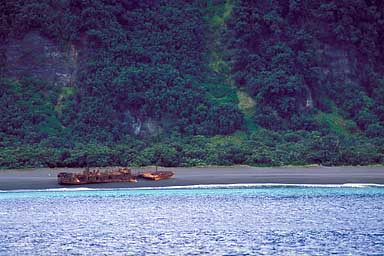 |
That day we had two
more great dives around Raoul, the second of which saw me escorted from
the water by particularly friendly locals. Being the last to leave the
water I knew that the sharks had come to like me and would want to say
good-bye. However, I couldn't help feeling they were getting a little
over friendly as I approached the boat and looked behind me where I counted
25 of them swimming into the current towards me, the closest almost ready
to nip at the tips of my fins.
After finishing diving for the day we decided to go ashore at Denham Bay to check out the wreck of a Japanese fishing boat driven ashore there. Although the bay was well sheltered from the prevailing weather, the beach is very steep and getting ashore without getting wet was not easy. Several members of the group did get knocked over in the surf but all was well until the sea decided to reclaim our inflatable dinghy. It had been pulled ashore, supposedly beyond the range of the waves but after leaving it unattended for a minute or two, we turned to see it floating upside down in the surf.
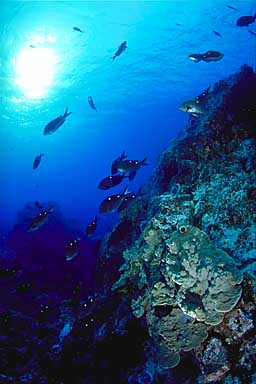 |
Upon rescue and inspection, the motor was found to be drenched in water, covered in sand and the chances of it getting us back to Atu, anchored well offshore, seemed remote. We joked about being shipwrecked on an island in the middle of nowhere and sent a few of the crew off in the dinghy to row the considerable distance to Atu. During the wait for the dinghy to return we explored some of the huge beach and wandered off into the bush behind it. Eventually the dinghy returned with a restarted motor and we were all "rescued".
That evening, the
planned night dive had only two keen participants, Neil and Simon. I did
my best to prepare them mentally for the dive by reminding them of the
enormous tiger shark caught at night, nearby at Fishing Rock. Apparently
undaunted they entered the water with high powered torches seeming to
light up the whole bay. Their dive was to last barely 20 minutes after
which they exited the water telling stories of mysterious things that
had bumped into them in the dark causing them to terminate the dive. Needless
to say, the trauma relief team was on hand (led by me) to administer the
appropriate counseling.
We were to have one more full days thoroughly enjoying diving at the Kermadecs.
By this time the unusual mix of fish species had begun to seem a lot more
familiar. The odd looking drummer, similar to but distinctly different
from our silver drummer. The bluefish, normally seen only as individuals
at home swam around in large herds of big individuals grazing from rocks
in shallow water. Lord Howe coralfish, yellow banded perch, toadstool
grouper, gold-ribbon grouper, spotted black grouper, painted moki, magpie
morwong, grey and blue knifefish, all seldom seen around mainland New
Zealand but encountered with great frequency at the Kermadecs. Then, a
multitude of species seldom or never seen at home; lion fish, moorish
idols, two species of small unfamiliar morays, yellow boxfish and numerous
others with which it is difficult to gain familiarity over the short time
we were at the Kermadecs.
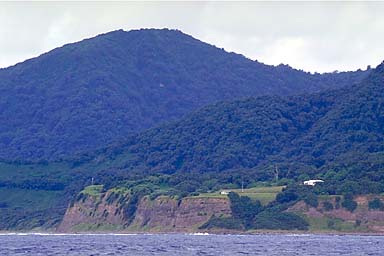 |
After five days at the Kermadecs we awoke to find the weather looking considerably less inviting. Our scheduled time to depart for home was drawing near and we were keen to keep an extra close eye on the weather and seize any windows that presented. A check of the latest weather fax confirmed that conditions at the Kermadecs were likely to deteriorate further and that two converging low pressure systems far to the south might make weather close to the mainland very unpleasant in a few days time.
We all felt lucky to have had such a good spell of weather at the Kermadecs and in the present miserable conditions, found it easy to make the decision to commence the long voyage home one day earlier than originally planned.
After ploughing our way east from Denham Bay through heavy swells, we dropped Drew, one of the DOC staff, at Boat Cove. There we lashed everything down and made final preparations for the rough seas that awaited us. At 2.00 pm we nudged our way out onto the big blue wobbly thing and soon began to loose site of a grey, wet, mist shrouded Raoul Island.
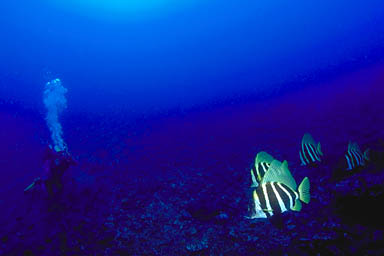 |
Anxiety levels were raised early into the voyage when it was announced that we had lost steering. At the time, it was beginning to get dark and we were bobbing about in a rather rough sea. After some frantic exploration it was found that a burst hydraulic hose was the cause of the problem. While using the two motors to keep the boat pointing roughly in the direction of the sea, a replacement hose was eventually found, fitted and the steering hydraulic system recharged with oil.
The days that followed
were not pleasant and graphically illustrated why the Kermadecs are so
seldom visited. During the long trip home there is absolutely no alternative
to accepting whatever mother nature dishes up. There are no shortcuts
and no places to shelter if you want a break. Your only hiding place is
your cabin bunk and for all of the trip home, these lurched about wildly
and were difficult or impossible to sleep in.
With each roll and
thud anything loose in the boat got relocated somewhat and with every
shower of spray that whipped across our decks, the salt water penetrated
cracks and appeared inside as constant drips or occasional bucket sized
drenchings. After a few days of this the boat began to look a mess. We
could have tidied things up a bit but doing anything that required moving
about the boat seemed like a huge effort and all we wanted to do was make
time disappear and set foot on dry land.
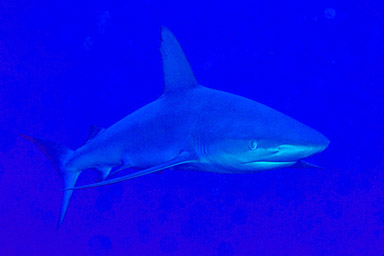 |
As we headed for the
mainland we were getting closer to a large high located over the South
Island. The sun shone for much of the time and the weather faxes indicated
that we should only be experiencing mild winds but the wind continued
to blow at 25 to 35 knots with gusts to 45 right up until we approached
Mayor Island on the third night of the voyage home when it finally began
to abate.
At 2 am, three and a half days after leaving Raoul Island, Atu pulled
into the marina at Tauranga where the lurching and rolling finally stopped.
Later in the morning we rose from our bunks and took a walk on dry land
only to find that it lurched about in a less pleasant way than Atu's motion
at sea. We were all very pleased to be back on the mainland but it had
been a magnificent trip and the memories of those far away islands would
stay with us forever.
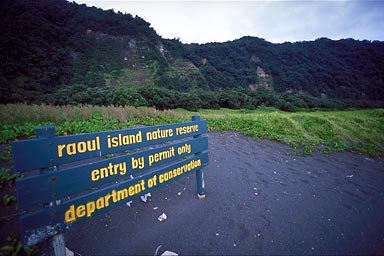 |
Photographic Notes:
Topside photographs were taken with a Nikon F601 with 16mm f2.8 fisheye,
18mm f3.5, 180mm f2.8 or 300mm f4.5 Nikkor lenses
with Fuji Provia film.
Underwater photographs were taken with a
Nikon F3 in an Aquatica 3 housing, 16mm f2.8 fisheye or 60mm f2.8 micro
Nikkor lenses, Ikelite Ai/n and Sea & Sea YS50 strobes with Fuji Velvia
or Provia film. Images presented
here were scanned onto Kodak Photo CD and prepared for this page with
Adobe Photoshop 6.
return to Skip's Underwater Image Gallery
return to ianskipworth.com
© 2001 ianskipworth.com
